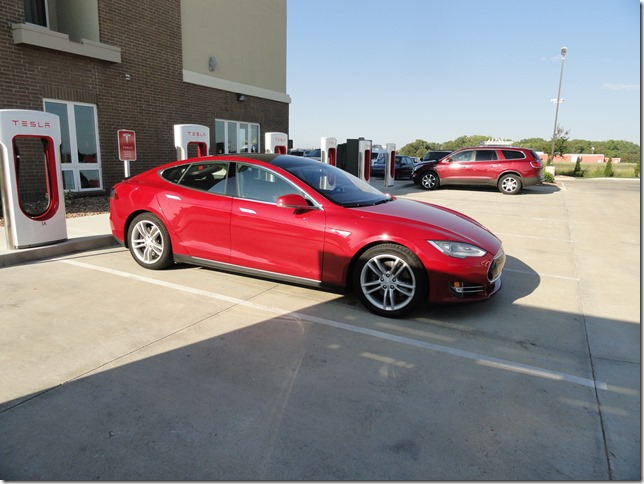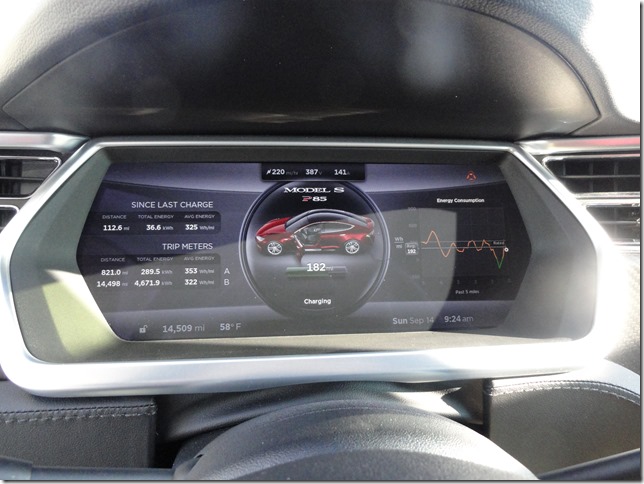I recently drove my red Tesla Model S P85 from Parker, CO to Kansas City, MO, which ended up being a round trip distance of about 1240 miles. This was my longest road trip ever in the Tesla, and it went very smoothly, with absolutely no problems from the car. There was also no “range-anxiety” on my part, especially since I am quite familiar with the car and what it can do.
I did learn something on the trip that was somewhat counter-intuitive. In an old-fashioned gasoline vehicle, you will generally make better time to your destination if you drive faster (subject to your fear of getting a speeding ticket). It is very common for the flow of traffic to be at least 5-10 mph above the posted speed limit on U.S. Interstate highways. The common limit in Colorado and Kansas is 75 mph, so traffic is generally going 80-85 mph.
As you go faster in any vehicle, your aerodynamic drag goes up quite dramatically, which affects your fuel consumption, whether you are burning gasoline or using electrons. In the Tesla, going 85 mph definitely has a noticeable effect on your power usage and range, even though the Tesla has a very low coefficient of drag.
Going east on this trip, I was going with the flow of traffic, which meant my range was less than the normal rated range. There was never any danger of running out, since I had planned my route, but it meant that I spent more time charging than I initially thought I would. I also charged higher than I needed to, to leave a larger battery reserve than I really needed.
Going west on the trip, I was going 75 mph. This meant that my energy usage per mile was lower, and I would arrive at each Supercharger station at a higher state of charge. I also did not spend extra time charging higher than I needed to. I would charge long enough to have enough range to make it to the next Supercharger, with a 50-60 mile reserve, which cut down on my total charging time. Consequently, I made much better overall time going home than I did on the outbound leg. Driving a little slower, charging less, and not charging as high at each stop made a huge difference in the overall trip time.
As far as trip impressions go, it was an interesting journey. When I pulled in to the first Supercharger in Limon, CO on the east-bound leg (which is next to an Arby’s restaurant), the car drew a bit of a crowd, with several people coming out of the Arby’s to take pictures of the car and ask me questions about it. The car drew similar attention at every other Supercharger stop.
In the Tesla community, we call this phenomena “Tesla Time”, where complete strangers will walk up to you and start asking lots and lots of questions about the car.
Here are some of the most common questions:
- What kind of car is that?
- It is a Tesla Model S
- Who makes it?
- Tesla Motors, in California
- How much does it cost?
- Anywhere from $70-110K, depending on the battery size and options
- Is it a hybrid?
- No, it is 100% electric
- What is the range?
- The 85 kWh battery model has a rated range of 265 miles. Your actual range depends on how fast you drive, the weather, elevation changes, etc.
- How long does it take to charge?
- That depends on what you plug it into. A Tesla Supercharger can do a complete charge in about 40-50 minutes. A Tesla HPWC can do a complete charge in about 4 hours. A 240V, 50 amp NEMA 14-50 outlet (like I have in my garage) can do a complete charge in about 8 hours. I just plug in whenever I come home, and I always have a full battery when I leave the house.
- How fast is it?
- The P85 model will do 0-60 in about 4.0 seconds. It is pretty quick…
- How much does it cost to charge?
- Tesla Superchargers are free. It costs me about $9.00 to do a full charge at home.
Figure 1: Charging in Salina, KS
Figure 2: Charging at a Supercharger, with the battery about 2/3 full



Very cool! Though, I think you are understating this point:
7.How fast is it?
A.The P85 model will do 0-60 in about 4.0 seconds. It is pretty quick…
That is a bit more than pretty quick 🙂 For a comparison, that is just a tad slower than a 2015 Corvette Stingray: http://www.chevrolet.com/corvette-sports-cars.html which states 3.8 seconds to 60. Or a little over twice as fast as these guys (http://www.peoriaford.com/ford-reviews/2014-c-max.htm ) state that my C-Max will do it, though they still have the lie MPG rating up of 47 up, so who knows)
Hello,
side question : aren’t you missing engine sound when pushing it? I mean like a mustang v8 engine sound provide ? 🙂
Not really missing the engine sounds. There is plenty of entertainment from the fast acceleration…
Very good review….no one else can put such a detailed notes other than a DBA :).
On a side note, does it take $70-100k to build such a car ? why it is so expensive ?
The actual manufacturing cost is quite a bit lower than that. Much of the cost comes from the Li-Ion batteries (the cost of which is coming down rapidly).